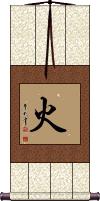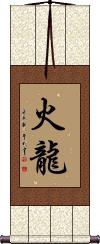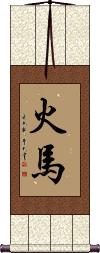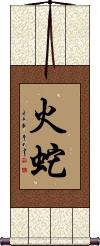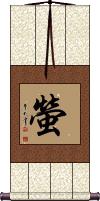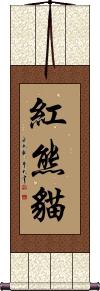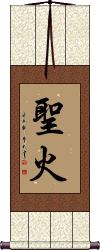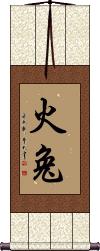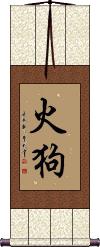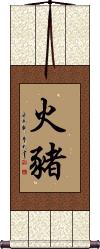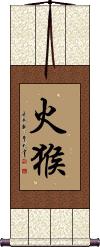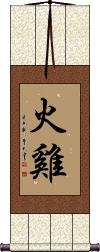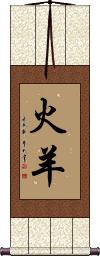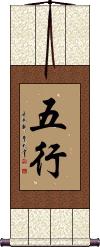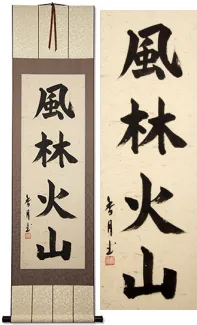Buy a Custom Fire Chinese or Japanese Calligraphy Wall Scroll
We have many options to create artwork with the Chinese characters / Asian symbols / Japanese Kanji for Fire on a wall scroll or portrait.
If you want to create a cool Fire wall scroll, this is the place. Below you will find a few Asian symbols that express the idea of Fire.
1. Fire
2. Fire Dragon
3. Fire Horse
4. Fire Snake
5. Fire and Water Have No Mercy
7. Fire Tiger
8. Green Fire
10. Sacred Fire
11. Will of Fire
13. Fire Tiger
14. Fire Rabbit
15. Fire Rat
16. Fire Ox/Bull
17. Fire Dog
18. Fire Pig/Boar
19. Fire Monkey
20. Fire Rooster
21. Fire Horse
22. Fire Goat/Sheep
23. Fire Dragon
24. Fire Snake
25. Five Elements
26. Ash
Fire
(One of the five elements)
火 is the symbol for fire, flame, or blaze in Chinese, Korean and Japanese.
Fire is one of the five elements that ancient Chinese believed all things were composed of. These elements are also part of the cycle of Chinese astrology. Every person has both an animal sign, and one of the five elements according to the date of their birth. See also Five Elements and Chinese 12 Animals / Zodiac.
See Also: Five Elements
Fire Dragon
Fire Horse
Fire Snake
Fire and Water Have No Mercy
Firefly / Glow Worm
螢 is the Chinese, older Japanese Kanji, and old Korean Hanja way to write firefly, lightning bug, or glow worm (Luciola cruciata).
![]() Note: After post WWII language reforms in Japan, they started using a more simple version of this Kanji. This version is shown to the right. If you want this modern Japanese version, please click on the Kanji to the right instead of the button above.
Note: After post WWII language reforms in Japan, they started using a more simple version of this Kanji. This version is shown to the right. If you want this modern Japanese version, please click on the Kanji to the right instead of the button above.
Fire Tiger
火虎 is the Chinese and Japanese title for “fire tiger.”
If you were born between 9 Feb 1986 and 28 Jan 1987, or between 13 Feb 1926 and 1 Feb 1927, you are a fire tiger according to the Chinese Zodiac.
There are 12 animals and 5 elements in the cycle. Therefore, the fire tiger comes around once every 60 years. The next will be in 2046.
The branch of the zodiac for tiger is written 寅 when dating ancient documents and artwork, but 虎 is the way to write the character for an actual tiger.
Green Fire
Red Panda / Firefox
Sacred Fire
聖火 is a Chinese, Japanese and Korean term that applies to the sacred fire of the ancient Greek Olympic torch or games.
This could also apply to other sacred or holy fires, as it can be a somewhat generic term.
Will of Fire
Earth Fire Water Air
Fire Tiger
The Year of the Fire Tiger
火虎 is Fire Tiger in Chinese.
In the Chinese zodiac and sexagenary (60-year) cycle, this combination occurs in years that include 1866, 1926, 1986, and 2046.
In the sexagenary cycle, this year is represented by 丙寅.
See Also: Tiger
Fire Rabbit
The Year of the Fire Rabbit
火兔 is Fire Rabbit in Chinese.
In the Chinese zodiac and sexagenary (60-year) cycle, this combination occurs in years that include 1867, 1927, 1987, and 2047.
In the sexagenary cycle, this year is represented by 丁卯.
See Also: Rabbit
Fire Rat
The Year of the Fire Rat
火鼠 is Fire Rat in Chinese.
In the Chinese zodiac and sexagenary (60-year) cycle, this combination occurs in years that include 1876, 1936, 1996, and 2056.
In the sexagenary cycle, this year is represented by 丙子.
See Also: Rat
Fire Ox/Bull
The Year of the Fire Ox/Bull
火牛 is Fire Ox/Bull in Chinese.
In the Chinese zodiac and sexagenary (60-year) cycle, this combination occurs in years that include 1877, 1937, 1997, and 2057.
In the sexagenary cycle, this year is represented by 丁丑.
See Also: Ox/Bull
Fire Dog
The Year of the Fire Dog
火狗 is Fire Dog in Chinese.
In the Chinese zodiac and sexagenary (60-year) cycle, this combination occurs in years that include 1886, 1946, 2006, and 2066.
In the sexagenary cycle, this year is represented by 丙戌.
See Also: Dog
Fire Pig/Boar
The Year of the Fire Pig/Boar
火豬 is Fire Pig/Boar in Chinese.
In the Chinese zodiac and sexagenary (60-year) cycle, this combination occurs in years that include 1887, 1947, 2007, and 2067.
In the sexagenary cycle, this year is represented by 丁亥.
See Also: Pig/Boar
Fire Monkey
The Year of the Fire Monkey
火猴 is Fire Monkey in Chinese.
In the Chinese zodiac and sexagenary (60-year) cycle, this combination occurs in years that include 1896, 1956, 2016, and 2076.
In the sexagenary cycle, this year is represented by 丙申.
See Also: Monkey
Fire Rooster
The Year of the Fire Rooster
火雞 is Fire Rooster in Chinese.
In the Chinese zodiac and sexagenary (60-year) cycle, this combination occurs in years that include 1897, 1957, 2017, and 2077.
In the sexagenary cycle, this year is represented by 丁酉.
See Also: Rooster
Fire Horse
The Year of the Fire Horse
火馬 is Fire Horse in Chinese.
In the Chinese zodiac and sexagenary (60-year) cycle, this combination occurs in years that include 1906, 1966, 2026, and 2086.
In the sexagenary cycle, this year is represented by 丙午.
See Also: Horse
Fire Goat/Sheep
The Year of the Fire Goat/Sheep
火羊 is Fire Goat/Sheep in Chinese.
In the Chinese zodiac and sexagenary (60-year) cycle, this combination occurs in years that include 1907, 1967, 2027, and 2087.
In the sexagenary cycle, this year is represented by 丁未.
See Also: Goat/Sheep
Fire Dragon
The Year of the Fire Dragon
火龍 is Fire Dragon in Chinese.
In the Chinese zodiac and sexagenary (60-year) cycle, this combination occurs in years that include 1916, 1976, 2036, and 2096.
In the sexagenary cycle, this year is represented by 丙辰.
See Also: Dragon
Fire Snake
The Year of the Fire Snake
火蛇 is Fire Snake in Chinese.
In the Chinese zodiac and sexagenary (60-year) cycle, this combination occurs in years that include 1917, 1977, 2037, and 2097.
In the sexagenary cycle, this year is represented by 丁巳.
See Also: Snake
Five Elements
五行 is the title of the five elements: wood, fire, water, earth, and metal.
The first character means five, and the second character is simply element(s).
According to ancient Chinese science, all matter in the world is comprised of these elements. One idea presented with the five elements is that when energy is added, the matter is believed to expand. When energy is removed, matter contracts. Oddly, this concept is not far from Einstein's theories and modern science. Just a few thousand years before Einstein.
More info: Wikipedia - Five Elements (Wu Xing).
See Also: Wood | Water | Earth | Metal | Five Elements
Five Elements
金木水火土 is a list of the Chinese characters for the five elements in a comfortable order (meaning that they “feel right” to a Chinese person who views this arrangement).
The order is metal, wood, water, fire, and earth.
Note that sometimes the metal element is translated as gold. And earth refers to soil versus the whole planet earth.
Five Elements
地水火風空 is the specifically-Japanese version of the five elements.
This is a little different than the ancient or original Chinese version.
The elements are written in this order:
1. Earth / Terra / Ground
2. Water
3. Fire
4. Wind / Air
5. Sky / Emptiness / Void / Ether
Note: This set of Kanji can also be romanized as “ji sui ka fuu kuu,” “jisuikafuukuu,” or “jisuikafuku.”
These can also be written in the order 地火風水空 (chi ka sui fuu kuu). Let me know when you place your order if you want the Kanji to be in this character order.
灰 is the Chinese, Japanese, and Korean word for ash or ashes.
This can also refer to dust, lime, or gray. When speaking of emotions in Chinese, it can refer to being discouraged or dejected.
In Japanese, this can be the surname, Hai.
Put out a burning wood cart with a cup of water
An utterly inadequate measure
杯水車薪 is a warning against a futile effort.
This proverb literally refers to one who is “trying to put out a burning cart of wood with a cup of water,” or “throw a cup of water on a cartload of wood.” The lesson to be learned is about using the right measure or tool for the job and not wasting your effort if you are inadequately equipped for the task at hand - in other words the postscript should be “go get a bucket or a fire hose.”
Phoenix Rise from the Ashes
鳳凰涅磐 is a proverb that suggests “Legendary Phoenix rises from the ashes.” It means “Legendary Phoenix [reaches] Nirvana.”
There is a legend in China of a great bird reborn once every 500 years. This bird gathers all the ill will, suffering, desire, and other negative things of the world. The bird then plunges into the fire to burn away all negative things, sacrificing itself in the process (achieving Nirvana, or perhaps allowing others the opportunity to reach Nirvana).
500 years later, the phoenix is reborn from the ashes again, and the cycle repeats.
This in-stock artwork might be what you are looking for, and ships right away...
Gallery Price: $200.00
Your Price: $122.88
The following table may be helpful for those studying Chinese or Japanese...
| Title | Characters | Romaji (Romanized Japanese) | Various forms of Romanized Chinese | |
| Fire | 火 | hi | huǒ / huo3 / huo | |
| Fire Dragon | 火龍 火龙 | hi ryuu / hiryuu / hi ryu | huǒ lóng / huo3 long2 / huo long / huolong | huo lung / huolung |
| Fire Horse | 火馬 火马 | oma hi / omahi | huǒ mǎ / huo3 ma3 / huo ma / huoma | |
| Fire Snake | 火蛇 | hi hebi / hihebi | huǒ shé / huo3 she2 / huo she / huoshe | |
| Fire and Water Have No Mercy | 水火無情 水火无情 | shuǐ huǒ wú qíng shui3 huo3 wu2 qing2 shui huo wu qing shuihuowuqing | shui huo wu ch`ing shuihuowuching shui huo wu ching |
|
| Firefly Glow Worm | 螢 萤 | hotaru | yíng / ying2 / ying | |
| Fire Tiger | 火虎 | hi tora / hitora | huǒ hǔ / huo3 hu3 / huo hu / huohu | |
| Green Fire | 爐火純青 炉火纯青 | lú huǒ chún qīng lu2 huo3 chun2 qing1 lu huo chun qing luhuochunqing | lu huo ch`un ch`ing luhuochunching lu huo chun ching |
|
| Red Panda Firefox | 紅熊貓 红熊猫 | hóng xióng māo hong2 xiong2 mao1 hong xiong mao hongxiongmao | hung hsiung mao hunghsiungmao |
|
| Sacred Fire | 聖火 圣火 | seika | shèng huǒ sheng4 huo3 sheng huo shenghuo | |
| Will of Fire | 火の意志 | hi no ishi / hinoishi | ||
| Earth Fire Water Air | 四大元素 | yondaigenso | ||
| Fire Tiger | 火虎 | huǒ hǔ / huo3 hu3 / huo hu / huohu | ||
| Fire Rabbit | 火兔 | huǒ tù / huo3 tu4 / huo tu / huotu | huo t`u / huotu / huo tu | |
| Fire Rat | 火鼠 | huǒ shǔ / huo3 shu3 / huo shu / huoshu | ||
| Fire Ox/Bull | 火牛 | huǒ niú / huo3 niu2 / huo niu / huoniu | ||
| Fire Dog | 火狗 | huǒ gǒu / huo3 gou3 / huo gou / huogou | huo kou / huokou | |
| Fire Pig/Boar | 火豬 火猪 | huǒ zhū / huo3 zhu1 / huo zhu / huozhu | huo chu / huochu | |
| Fire Monkey | 火猴 | huǒ hóu / huo3 hou2 / huo hou / huohou | ||
| Fire Rooster | 火雞 火鸡 | huǒ jī / huo3 ji1 / huo ji / huoji | huo chi / huochi | |
| Fire Horse | 火馬 火马 | huǒ mǎ / huo3 ma3 / huo ma / huoma | ||
| Fire Goat/Sheep | 火羊 | huǒ yáng / huo3 yang2 / huo yang / huoyang | ||
| Fire Dragon | 火龍 火龙 | huǒ lóng / huo3 long2 / huo long / huolong | huo lung / huolung | |
| Fire Snake | 火蛇 | huǒ shé / huo3 she2 / huo she / huoshe | ||
| Five Elements | 五行 | gogyou / gogyo | wǔ xíng / wu3 xing2 / wu xing / wuxing | wu hsing / wuhsing |
| Five Elements | 金木水火土 | jīn mù shuǐ huǒ tǔ jin1 mu4 shui3 huo3 tu3 jin mu shui huo tu jinmushuihuotu | chin mu shui huo t`u chinmushuihuotu chin mu shui huo tu |
|
| Five Elements | 地水火風空 地水火风空 | chi sui ka fuu kuu chisuikafuukuu chi sui ka fu ku | ||
| Ash | 灰 | hai | huī / hui1 / hui | |
| Put out a burning wood cart with a cup of water | 杯水車薪 杯水车薪 | bēi shuǐ chē xīn bei1 shui3 che1 xin1 bei shui che xin beishuichexin | pei shui ch`e hsin peishuichehsin pei shui che hsin |
|
| Phoenix Rise from the Ashes | 鳳凰涅磐 凤凰涅磐 | fèng huáng niè pán feng4 huang2 nie4 pan2 feng huang nie pan fenghuangniepan | feng huang nieh p`an fenghuangniehpan feng huang nieh pan |
|
| In some entries above you will see that characters have different versions above and below a line. In these cases, the characters above the line are Traditional Chinese, while the ones below are Simplified Chinese. | ||||
